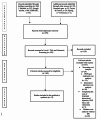Determining direct, indirect healthcare and social costs for diabetic retinopathy management: a systematic review
- PMID: 39350064
- PMCID: PMC11441148
- DOI: 10.1186/s12886-024-03665-6
Determining direct, indirect healthcare and social costs for diabetic retinopathy management: a systematic review
Abstract
Introduction: Diabetic retinopathy (DR) is a rapidly growing global public health threat; it affects 1 in 3 people with diabetes and is still the leading cause of blindness among the working-age population. The management of diabetic retinopathy is becoming more advanced and effective but is highly expensive compared to other ocular diseases.
Aim: To report direct medical, indirect medical, and nonmedical costs of diabetic retinopathy in developed and developing countries through a systematic review.
Methods: Related articles published in the PubMed, Google Scholar, and EMBASE electronic databases from 1985 to 2022 were identified using the keywords direct medical and indirect medical and social costs of diabetic retinopathy. However, previous systematic reviews, abstracts, and case reports were excluded.
Results: Thirteen articles were eligible for assessing the economic burden of diabetes management and its complications. Our analysis revealed that increasing prevalence and severity of diabetic retinopathy (DR) are associated with higher direct and indirect healthcare expenditures. The impact of DR on working-age adults, leading to irreversible blindness in advanced stages, underscores the urgent need for cost-effective prevention and management strategies.
Discussion: This study systematically reviewed the direct medical, indirect medical, and nonmedical costs of DR in developed and developing countries. Our findings highlight the significant economic burden of DR, emphasizing the importance of implementing effective prevention and management measures to alleviate costs and enhance patient outcomes.
Conclusion: The substantial financial burden of DR necessitates a re-evaluation of current screening and management programs. Revision of these programs is crucial to improve quality of care, reduce costs, and ultimately achieve Sustainable Development Goal 3, which aims to ensure good health and well-being for all.
Keywords: And indirect nonmedical cost; Diabetes; Diabetic retinopathy; Direct medical cost; Indirect medical cost.
© 2024. The Author(s).
Conflict of interest statement
The authors declare no competing interests.
Figures
Similar articles
-
The estimated healthcare cost of diabetic retinopathy in Indonesia and its projection for 2025.Br J Ophthalmol. 2020 Apr;104(4):487-492. doi: 10.1136/bjophthalmol-2019-313997. Epub 2019 Jul 8. Br J Ophthalmol. 2020. PMID: 31285276
-
Rapid assessment of avoidable blindness-based healthcare costs of diabetic retinopathy in Hungary and its projection for the year 2045.Br J Ophthalmol. 2021 Aug;105(8):1116-1120. doi: 10.1136/bjophthalmol-2020-316337. Epub 2020 Aug 11. Br J Ophthalmol. 2021. PMID: 32788328
-
United States comparative costs and absenteeism of diabetic ophthalmic conditions.Postgrad Med. 2015 Jun;127(5):455-62. doi: 10.1080/00325481.2014.994468. Epub 2014 Dec 31. Postgrad Med. 2015. PMID: 25549691
-
Global Prevalence of Diabetic Retinopathy and Projection of Burden through 2045: Systematic Review and Meta-analysis.Ophthalmology. 2021 Nov;128(11):1580-1591. doi: 10.1016/j.ophtha.2021.04.027. Epub 2021 May 1. Ophthalmology. 2021. PMID: 33940045
-
Cost-effectiveness of diabetic retinopathy screening programs using telemedicine: a systematic review.Cost Eff Resour Alloc. 2020 Apr 6;18:16. doi: 10.1186/s12962-020-00211-1. eCollection 2020. Cost Eff Resour Alloc. 2020. PMID: 32280309 Free PMC article. Review.
Cited by
-
Financial Toxicity in Diabetes: The State of What We Know.Curr Diab Rep. 2025 May 13;25(1):32. doi: 10.1007/s11892-025-01588-0. Curr Diab Rep. 2025. PMID: 40358737 Free PMC article. Review.
-
Eye care interventions that reduce access inequities for women, rural residents and older people in low-middle-income countries: a scoping review.Front Public Health. 2025 Jun 23;13:1578848. doi: 10.3389/fpubh.2025.1578848. eCollection 2025. Front Public Health. 2025. PMID: 40626165 Free PMC article.
-
Correlation Between the Ratio of Uric Acid to High-Density Lipoprotein Cholesterol (UHR) and Diabetic Retinopathy in Patients with Type 2 Diabetes Mellitus:A Cross-Sectional Study.Diabetes Metab Syndr Obes. 2025 Jan 20;18:173-183. doi: 10.2147/DMSO.S504308. eCollection 2025. Diabetes Metab Syndr Obes. 2025. PMID: 39866522 Free PMC article.
-
Resveratrol as a Novel Therapeutic Approach for Diabetic Retinopathy: Molecular Mechanisms, Clinical Potential, and Future Challenges.Molecules. 2025 Aug 4;30(15):3262. doi: 10.3390/molecules30153262. Molecules. 2025. PMID: 40807437 Free PMC article. Review.
-
Depression and diabetic retinopathy: an underexplored connection.Front Nutr. 2025 Apr 11;12:1557105. doi: 10.3389/fnut.2025.1557105. eCollection 2025. Front Nutr. 2025. PMID: 40290656 Free PMC article.
References
-
- Wong TY, Sabanayagam C. Strategies to tackle the global burden of diabetic retinopathy: from epidemiology to artificial intelligence. Ophthalmologica. 2019;243(1):9–20. 10.1159/000502387 - PubMed
-
- World report on vision. World Health Organization. Cited 2024 Jan 11]; https://www.who.int/publications/i/item/9789241516570
-
- WHO Model List of Essential Medicines – 22nd list. 2021. World Health Organization. Cited 2024 Jan 13]; https://www.who.int/publications/i/item/WHO-MHP-HPS-EML-2021.02
-
- Rein DB, Zhang P, Wirth KE, Lee PP, Hoerger TJ, McCall N et al. The economic burden of major adult visual disorders in the United States. Archives of Ophthalmology. 2006;124(12):1754. 10.1001/archopht.124.12.1754 - PubMed
Publication types
MeSH terms
LinkOut - more resources
Full Text Sources
Medical


